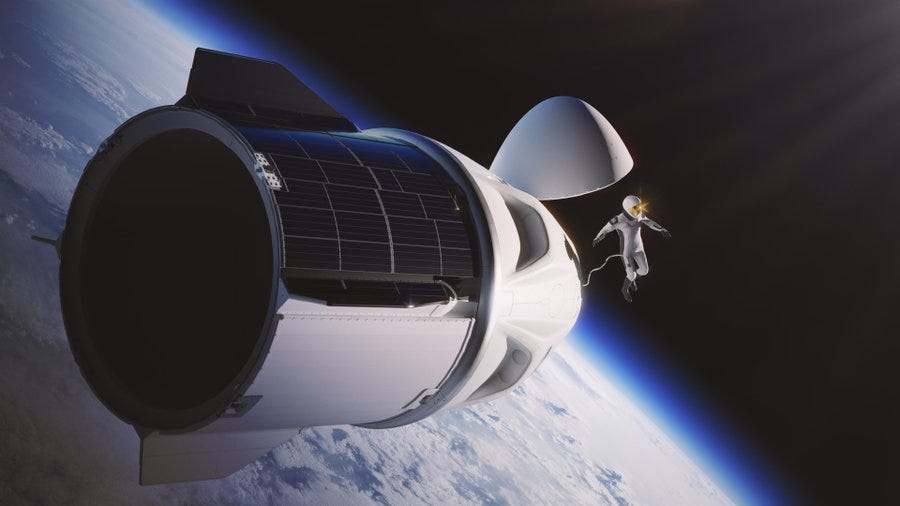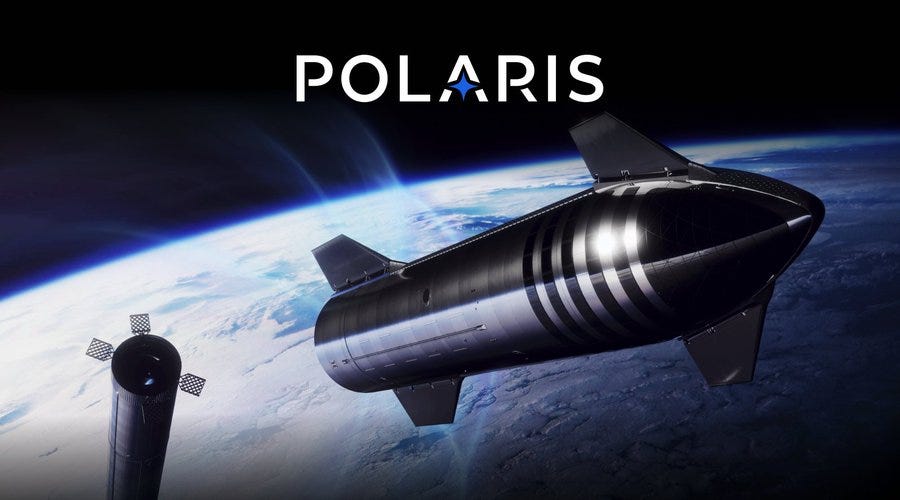Purpose of Polaris Program
Subtitle: Dawn of Citizen Space
Polaris, a constellation of three stars more commonly known as the North Star, has been a guiding light throughout human history to help navigate the world around us and the sky above.” ~ Polaris Site
In February 2022, following the success of Inspiration4 (the first all commercial astronaut mission), Jared Isaacman announced he would partner with SpaceX and St. Jude Children's Research Hospital to create the Polaris Program (a conjunction of three stars from diverse fields). This ambitious privately funded space program will consist of 3 missions, the first two employing a Crew Dragon spacecraft launched on Falcon 9, followed by the first flight of Starship with crew onboard. The aim of this novel program is: -
“to rapidly advance human spaceflight capabilities, while continuing to raise funds and awareness for important causes here on Earth.”
Essentially the three partners have agreed to support a series of manned space flights in order to achieve their individual and common goals. However, these parties have been fairly reserved about what they wish to achieve from the Polaris Program over the long term, which must be highly valuable considering their overall commitment of time and resources.
SpaceX Goals
Since NASA’s inception, in the late 1950’s, it has completed countless scientific studies of the space environment, including its effects on astronaut’s bodies. While perfectly worthwhile, we are now entering a new space era of long duration space flights, culminating in the colonization of new worlds. Hence SpaceX needs to investigate practical techniques for handling the space environment, both for their Starship vehicles and the many people carried onboard.

The first Polaris mission, called Polaris Dawn, is due to launch in September 2023. This 5 day mission will be used to monitor some of the serious hazards associated with space travel e.g: SANS (Spaceflight Associated Neuro-Ocular Syndrome), VGE (Venous Gas Embolism), radiation exposure and variations in human makeup/processes. SpaceX want to send ordinary people on Starship, who are likely less resilient than astronauts, so finding ways to mitigate these common space hazards has become a priority. In the long run, they plan to send thousands of people to the moon and hundreds of thousands to Mars, and deliver them in the best condition possible to meet the challenges of these new worlds.
During the Inspiration4 mission communications was fairly intermittent because it shared NASA’s Tracking and Data Relay Satellite (TDRS) network. Hence the Polaris Dawn crew will attempt to establish laser communications with SpaceX’s own Starlink constellation, which should provide uninterrupted connection and broader bandwidth. Taking the long view, this is a necessary first step towards creating a deep space laser communications network, involving Starlink derived satellites deployed around each new world.
Last but not least, they plan to test the new SpaceX designed extravehicular activity (EVA) spacesuits, on a tethered spacewalk. If successful, these EVA suits will become the core technology for the surface suits SpaceX will use on the moon and Mars.
“Building a base on the Moon and a city on Mars will require thousands of spacesuits; the development of this suit and the execution of the EVA will be important steps toward a scalable design for spacesuits on future long-duration missions.” ~ Polaris Site
On the second Polaris flight they want to use a Crew Dragon vehicle to rendezvous with the Hubble Space Telescope. This should allow them to perform some repairs and upgrades before boosting the telescope to a higher orbit, effectively extending its life. SpaceX intend to build a large network of propellant depots (500+) in Low Earth Orbit (LEO) to refuel all of the Starships sent to the moon and Mars (estimated at 1,000+ spacecraft). Experience gained servicing the Hubble will likely prove invaluable when they need to maintain such large numbers of propellant depots and Starships without returning them to Earth.
The final Polaris mission will primarily be used to prove Starship is safe for passenger transport. Realistically not the last step before colonizing other worlds but an important one nonetheless. No doubt they will take this opportunity to perform some operations in LEO to showcase the vehicle’s unparalleled utility, possibly involving the retrieval of Starlink satellites.
“Let’s say you have a satellite and you launch and something goes wrong… Starship has a capability to open its payload bay, either bring the satellite back in, close it, pressurize it, work on it and redeploy it.” ~ SpaceX COO Gwynne Shotwell at the IE Business School, Madrid
Jared Isaacman’s Goals
The billionaire Jared Isaacman graduated from Space Camp and is a professed space nerd. He has taken SpaceX’s words to heart that space access should become as easy as air travel, and plans to go to space regularly to assist the process. Beyond that Jared is committed to pushing the bounds; he was insistent the Inspiration4 spacecraft should orbit above the International Space Station (at 540km altitude) and plans to set a new Earth orbit record for the Polaris Dawn mission, with a maximum altitude exceeding 1,360km. Jared Isaacman defines what it is to be a leader, someone willing to put himself on the line to enact a greater vision, one he shares with SpaceX.
“The Polaris Program seeks to demonstrate important operational capabilities that will serve as building blocks to help further human exploration to the Moon, Mars, and beyond.” ~ Polaris Site
He’s not a “one and done” type billionaire who goes to space for bragging rights, he’s a hardcore entrepreneur with a history of converting personal interests into business opportunities. His first company was Shift4 Payments, which arose from his childhood love of computing, followed by Draken International, which turned his passion for high performance aircraft into a flight training business. At some point then it seems inevitable he will leverage his current experience to engender some kind of space related business – like his own version of Airbnb for the moon! Whatever he decides, this will likely occur a little further down the line as his ambition to go ever farther appears to exceed the limits of the Polaris Program. When asked whether he would go to Mars, and his wife’s thoughts on that, his response was: -
“Yeh…I’m quite sure that my wife, if she knew that there was again a very high confidence and success in return, she’d be supportive of it but there’s a lot that needs to be accomplished before that including getting the first crewed Starship into Low Earth Orbit.” ~ Jared Isaacman interview by Everyday Astronaut
No doubt Jared would jump at the chance of becoming the first person on Mars, given his drive to achieve space firsts. Sounds ambitious but no-one would be better prepared, following his experience as commander of three formative missions. No doubt many believe a NASA astronaut should be the first to set foot on Mars, similar to the Apollo moon landings. However, NASA are committed to using their own Space Launch System to reach Mars, in part to maintain congressional support for their budget. Hence if Starship is ready to go before SLS…SpaceX might have to select their own crew for this mission, with Jared Isaacman in pole position. Also, as Jared alluded, the first landers on Mars are not guaranteed to return, primarily due to difficulties producing sufficient quantities of propellant on Mars for a return flight. It seems unlikely NASA would ignore this risk given they are accountable to the public and astronaut’s families for their safety and wellbeing. Whereas private citizens like Isaacman face far less restrictions, and he certainly appears motivated...
“...just being in Starbase [SpaceX’s spaceport in Boca Chica Texas] feels like a religious experience and what they are working on there can really change everything.” ~ Jared Isaacman interview by Everyday Astronaut
No doubt the Mayflower Pilgrims felt something similar before they set out to colonize the new world. In the case of the moon or Mars the technical challenges will be much greater considering they have little to no atmosphere and experience temperature extremes which are far from Earth norms.
St Jude’s Goals
Following the Inspiration4 flight, St Jude received more than $250m in charitable donations, helping to fund the Inspiration4 Advanced Research Center on their Memphis campus. Their goal is to defeat childhood cancer and with any luck the series of flights proposed for the Polaris program could become a source of sustained sponsorship. Broad following by the mainstream and internet media could offer no better showcase for their groundbreaking efforts and heartfelt humanity.
In addition, any effort to colonize other worlds implies raising families there, which won’t be easy due to increased radiation exposure. This is more hazardous for the young because their cells multiply relatively quickly which makes them more susceptible to cancer. However, St Jude Children’s Hospital have increased long term survival rates to 80% so far. Hopefully by the time we reach the moon or Mars, the threat of cancer will have retreated to become an easily treatable problem (likely through advanced techniques like immunotherapy backed by Crispr). Currently St Jude’s strive to spread their life saving techniques around the world, which suggests they will be unfaltering in their support to go beyond.
In Conclusion
On the face of it, creating the first private space program, without NASA funding, sounds extravagant – until you examine the context. SpaceX have driven down the price of space launch through their fleet of reusable rockets and spacecraft, to the point where a unicorn billionaire like Isaacman can comfortably finance three launch missions. From their perspective Polaris is an unavoidable step towards their combined goal of democratizing space and colonizing new worlds. The techniques they learn and technologies they build are best won through direct experience of the space environment, considering the urgency of this effort and difficulties involved. Whether they succeed in all their goals is not so important as what they learn, lighting the way forward like Polaris.



